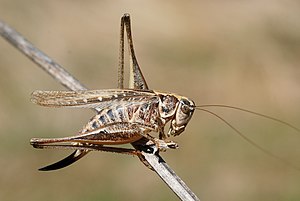Southern snake
| Southern snake | ||||||||||||
|---|---|---|---|---|---|---|---|---|---|---|---|---|

Southern bite insect ( Platycleis affinis ) |
||||||||||||
| Systematics | ||||||||||||
|
||||||||||||
| Scientific name | ||||||||||||
| Platycleis affinis | ||||||||||||
| Fever , 1853 |
The southern biting insect ( Platycleis affinis ) is a long-nosed insect from the family of the whooper terrors within the superfamily of the leaf locust . Some very similar species are classified in their genus . So far, two subspecies have been distinguished.
features
The southern biting insect is very similar to the western one and the gray biting insect (which is controversial because of the systematics of the genus Platycleis ) . Sure distinguishing features in males are the structure of the genital organs, in females a hump in front of the subgenital plate on the 7th abdominal plate and the narrower, not so strongly curved, reddish-brown ovary . In addition, with a body length of 20 to 28 millimeters, the insect is slightly larger than the species mentioned. The basic color is yellow-brown, often with a reddish tint, especially on the wings and the strong legs, which are reinforced with small spines on the lower legs. The entire body is covered in a faint, fuzzy dark pattern. The thighs of the last pair of legs bear a black vertical line, the inside of the thighs are tinted beige and reddish. The rear edge of the pronotum lateral lobes is light beige in color. The top of the head and pronotum are more monochrome than the rest of the body. The underside of the abdomen is beige and has no pattern. The southern bite has dark, body-length antennae and gray-brown wings that protrude beyond the ovipositor in the female. They carry several short, thin and parallel slashes. The compound eyes are light brown with a thin, dark pattern and a dark brown point in the middle. Researchers at the University of Derby in England have also found that the southern bite insect is the animal with the relatively largest testicles . They make up 14% of the total body weight.
Way of life and distribution
The southern biting insect is often found on blades of grass and in low vegetation and inhabits meadows, fields and dry, steppe-like wasteland. In Central Europe it is only widespread in Lower Austria and on Lake Neusiedl , where it often occurs together with the gray bite. It is absent in both Germany and Switzerland . Outside of Central Europe, they exist in the Mediterranean region . There it occurs in Spain , southern France , Greece and on surrounding islands in the Aegean and Ionian Seas , in Turkey and in Palestine . The adults appear from July to September.
Systematics
So far, two subspecies have been distinguished:
- P. a. affinis - fever, 1853 - comes in the western Mediterranean and in Palestine before
- P. a. fabriciana - Ander, 1948 - occurs only in Greece and the surrounding islands
A synonym of the subspecies affinis is P. a. boscae .
swell
literature
- Heiko Bellmann : The Cosmos Locust Leader. Determine the species of Central Europe with certainty. Franckh-Kosmos Verlags GmbH & Co. KG, Stuttgart 2006, ISBN 3440104478